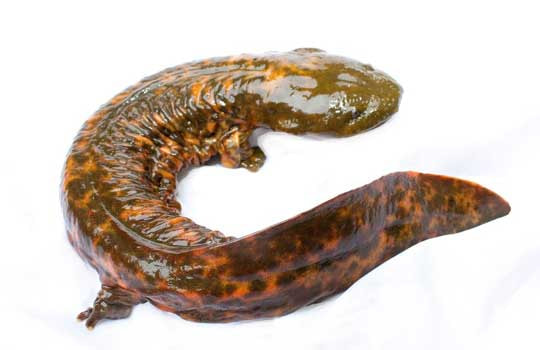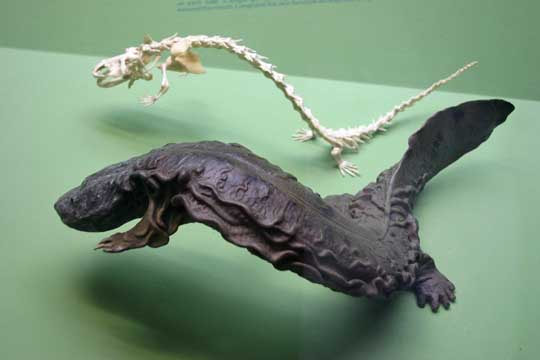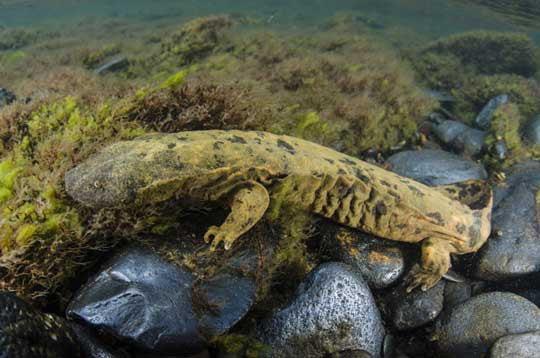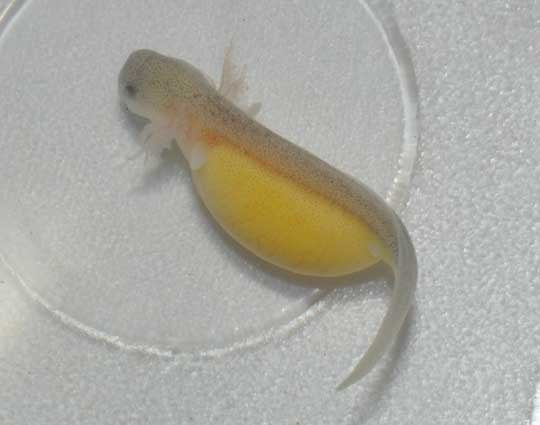|
My brother, Shane Smith, recently emailed me an article about how Pennsylvania named the "snot otter" as their official state amphibian. Well, not only is snot otter one of the most awesome colloquial names ever given to an animal, but the animal itself is quite awesome (officially known as the hellbender). So, I apologize to those of you who prefer the cute and cuddly creatures, because today's animal is, well... not (or should I say, It'snot). I can't help it—I'm fascinated by all reptiles and amphibians. Always have been. And since the hellbender is a salamander, which is an amphibian, it deserves to be recognized for its awesomeness. What the heck is a Hellbender? Hellbenders are the largest type of salamander in North America. They are considered "living fossils" because they have not changed much in the last 160 million years. These salamanders live on the bottoms of fast-flowing streams, and their bodies are flattened to help them cling to the rocky stream bottom. Amazing facts about Hellbenders Hellbenders are big. They are in a family, referred to as the giant salamanders, that includes only two other species, the Japanese giant salamander and the Chinese giant salamander. Hellbenders grow to 12 to 29 inches (30 to 74 cm) long, including the tail. And they weigh up to four pounds (1.8 kg). This is much larger than any of the other salamanders that live in their range. Hellbenders are predators. Mostly they prey on crayfish (90% of their diet is crayfish). But when they get the chance, they also snarf up fish, insects, earthworms, snails, tadpoles, fish eggs, and even other hellbenders. They have a "sit and wait" hunting strategy. They hide under rocks with only their heads sticking out, and when a crayfish swims too near, they open their mouth and suck in water, bringing the unfortunate crayfish with it. Hellbenders have numerous other names. Snot otter is my favorite, but other names include devil dog, mud devil, grampus, Allegheny alligator, spotted water gecko, leverian water newt, and another favorite of mine, lasagna lizard. The name lasagna lizard comes from the unusual folds of skin along the hellbender's side (these folds are obvious in the photo below). The name snot otter is obviously due to the slime that covers the hellbender's skin (this slime serves as a protective layer). No one knows for sure how it got the name hellbender, but some people believe the creature was named by settlers who felt that "it was a creature from hell where it's bent on returning." Anyway, hellbender is an intimidating name, one which is not really deserved, considering these salamanders are shy and timid. You might think a hellbender's slime is gross, but it's very important. Not only does it protect them from abrasions from rocks, it also makes them slippery, which in turn makes them difficult for predators (such as fish, turtles, and snakes) to hold onto. And when they are being pursued, they quickly secrete even more slime, which happens to taste awful to predators. So even if a predator manages to grab ahold of one, it gets a mouthful of nasty slime and will often let go. Okay, let's talk some more about the hellbender's amazing skin. What's up with all those lasagna folds? Here's an explanation: Young hellbenders (called larvae) have external gills for breathing. But as they grow to adulthood, their gills disappear. From that point on, they get all their oxygen through their skin. This isn't unusual for salamanders, but most other salamanders are much smaller. The larger an animal is, the less skin it has per unit of volume. It's that old "surface area to volume ratio" thing we all learned about in school. Small salamanders have more skin per gram of body weight, so their skin can easily absorb enough oxygen. But a four-pound hellbender simply needs more skin to get enough oxygen to support its massive body. That's why it has all those folds on its sides. That's also why hellbenders must live in well-oxygenated, fast-moving streams. The hellbender's skin has another superpower—it can see. That's right, the creature's skin contains numerous light-sensitive cells. It is thought that these cells help the salamander know whether it is well hidden beneath a rock. For example, the tail has the highest concentration of these cells, so that the hellbender can know whether or not its tail is sticking out. That's pretty darn amazing. The two tiny eyes on top of its head can also detect light but are not good at seeing images. So hellbenders use their strong sense of smell to catch prey. They also have a "lateral line" along each side of the body, which detects slight vibrations in the water. Check out this fun musical video about hellbenders! Hellbenders grow slowly and live a long time. It takes a young hellbender 5 to 8 years to reach sexual maturity, and they live up to 30 years in the wild. Hellbenders are not very sociable. Other than during the mating season, they spend all their time alone. In fact, when two adult hellbenders encounter each other, this almost always results in a fight. If they are about the same size, they will end up going their separate ways unharmed. But if one is smaller, it might get gobbled up by the larger one. I guess hellbenders aren't grossed out by hellbender slime. Hellbenders have rather unusual breeding habits. During the fall mating season, each adult male uses its strong legs to dig out a brood site, which is a saucer-shaped hole beneath a large rock, positioned so that well-oxygenated water flows directly over the hole. Then the male sits there in the brood site and waits for a female to come along. When a female does show up, he will coax (or force) her into his brood hole and will not let her leave until she lays her eggs (up to 200 eggs at once). The male then sprays his sperm over the eggs and swishes his tail to evenly distribute the sperm. The male then drives the female away and often tries to coax other females to add more eggs to his brood site. Some successful males will end up with almost 2,000 eggs! The male then guards the eggs by standing over them and rocking back and forth to increase the oxygen getting to them. The eggs hatch after about 45 days in warm regions, but it can take 75 days in colder areas. The young then swim off and try to survive on their own. See the hellbender larva below. So, the Hellbender deserves a place in the R.A.H.O.F. (Riveting Animal Hall of Fame). FUN FACT: The word rivet was first used in the late 1300s, and it came from the Middle English rivette, which meant to attach. As a noun, rivet means a metal pin that holds things together. As a verb, rivet means to fasten or fix firmly. At some point, the meaning expanded to also mean to firmly hold people's attention. Example: Avengers: Endgame is said to be a riveting movie. And since hellbenders are so fascinating, the word fits well here. In other words, riveting is another way to say awesome! Photo Credits:
Hellbender #1 - Brian Gratwicke via FLICKR Hellbender and hellbender skeleton - Ryan Somma via Flickr Hellbender in stream - Pete Oxford via The Orianne Society Hellbender larva - Mark Wanner, Saint Louis Zoo
0 Comments
Leave a Reply. |
Stan's Cogitations
Everyone needs a creative outlet. That's why I write. Archives
July 2024
|





 RSS Feed
RSS Feed